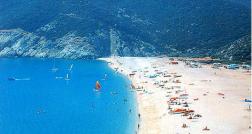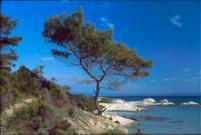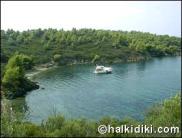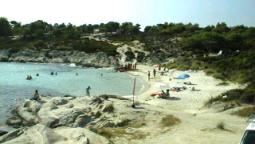Sithonia
 Sithonia is the second peninsula of Halkidiki. This middle prong has managed to retain its wild beauty and spirit, and it is the most appropriate destination for those seeking refuge from the trappings of civilization. From the top of the highest peak, Mt Dragoudelis (811 metres), you can enjoy a magnificent view of the whole of Sithonia, with the conical Mt Athos visible to the east and Kassandra to the west. Tiny beach coves abound with a mix of deep blue and emerald green waters. The coastline is attractively varied - a succession of fishermen's hamlets, picturesque little harbours, deserted beaches of all sizes surrounded by trees and bushes. Tourist resorts are developing rapidly, offering an attractive alternative to Kassandra. A more developed side to Sithonia can be found in areas like the tropical-like Toroni, the picturesque natural harbour of Porto Koufo, the sandy beach of Sykia, the lengthy joyful beach of Sarti and the cosmopolitan Neos Marmaras. Sithonia is the second peninsula of Halkidiki. This middle prong has managed to retain its wild beauty and spirit, and it is the most appropriate destination for those seeking refuge from the trappings of civilization. From the top of the highest peak, Mt Dragoudelis (811 metres), you can enjoy a magnificent view of the whole of Sithonia, with the conical Mt Athos visible to the east and Kassandra to the west. Tiny beach coves abound with a mix of deep blue and emerald green waters. The coastline is attractively varied - a succession of fishermen's hamlets, picturesque little harbours, deserted beaches of all sizes surrounded by trees and bushes. Tourist resorts are developing rapidly, offering an attractive alternative to Kassandra. A more developed side to Sithonia can be found in areas like the tropical-like Toroni, the picturesque natural harbour of Porto Koufo, the sandy beach of Sykia, the lengthy joyful beach of Sarti and the cosmopolitan Neos Marmaras.
Vourvourou is known for its natural beauty. It is something unique with more than ten small islands, enchanting seduced beaches and unspoiled scenery. During the 60's, the teaching staff of the University of Thessaloniki developed a holiday resort in Vourvourou, known nation-wide for its revolutionary design and respect for natural surroundings. Visitors should also visit the chapel of Panagia and the Great Wall - a defensive work of unknown era, dividing Sithonia from the rest of Halkidiki.
 Thoukididis, the ancient Greek historian, mentions the place as the "kophos limen" which means the silent harbour. And indeed Porto Koufo, with its rocky shores containing large caves, is one of the safest natural harbours in Greece. Greenery surrounds this seafront village - part of the Toroni municipality - whose residents and visitors revel in the sight of crystal-clear waters lapping onto a long sandy beach. Fishing boats loll about at the harbour as their owners shake out their nets, smiling and laughing no matter what the day's catch. Thoukididis, the ancient Greek historian, mentions the place as the "kophos limen" which means the silent harbour. And indeed Porto Koufo, with its rocky shores containing large caves, is one of the safest natural harbours in Greece. Greenery surrounds this seafront village - part of the Toroni municipality - whose residents and visitors revel in the sight of crystal-clear waters lapping onto a long sandy beach. Fishing boats loll about at the harbour as their owners shake out their nets, smiling and laughing no matter what the day's catch.
After Porto Koufo we find the 19th century traditional settlement of Sykia, or "Logos" as was named in some Athonite documents of the Byzantine period, one of the largest villages in Sithonia. The visitor should not miss the parish church, dedicated to St. Athanasius, with its carved wooden shrines. The beautiful beach of Sykia, is 3 km away from the village. There are lots of hotels, rented rooms, camping grounds, restaurants, bars and clubs here. To the west of the village, on the "Koukos" hill, there are the remains of a fortress and evidence of a prehistoric settlement. On this site, a systematic excavation of an early Iron Age cemetery (10th to 8th BC centuries) began in September 1987. So far, many tombs have been investigated and the grave offerings, which have survived, are of exceptional interest.
One of the most visited places in northern Greece, Toroni, is famous not only for its almost tropical beaches, but also for its position in Greek history. The present-day settlement bears the name of ancient Torone, which was colonized from Halkis in the 8th century BC and flourished in the Classical period. Excavations that have been carried out on the area brought to light sections of the fortifications of the ancient Torone, including a round tower and the walls of an acropolis. Mt Itamos, full of pine trees, looks proudly over the virgin coastline. Toroni is one of the few areas in Greece where diving is permitted.
Sarti is another favourite destination where it is said that from the local beach one can count the monasteries on Mt Athos in the distance. Fireworks light up the beach on August 15, during the Assumption of the Virgin Mary celebrations, when the moon is at its fullest. Significant ruins of the ancient city can be found above the gulf of Sykia. It is not known when or why the city was destroyed. During the 14th century, there are reports of a village in the area called "Sarti", belonging to the Monastery of Xenofontos. The locals are very hospitable. There are numerous hotels and rooms to rent, as well as stores, tavernas and cafés.
 Located on the east coast, Neos Marmaras is a cosmopolitan resort area, probably the most popular in Sithonia. It combines sea and mountain, wild entertainment and romantic walks, greek and international cuisine in a unique way. Beaches nestle at the bottom of Mount Meliton, which is dotted with citrus, almond and pine trees along with the grapes that go into making the globally known Carras wines. You can try them at the local wine-tasting centre, which is part of the Porto Carras tourist resort. Neos Marmaras, combining relaxation with entertainment, total unwinding with intense activity, appeals to all ages and all possible preferences. Located on the east coast, Neos Marmaras is a cosmopolitan resort area, probably the most popular in Sithonia. It combines sea and mountain, wild entertainment and romantic walks, greek and international cuisine in a unique way. Beaches nestle at the bottom of Mount Meliton, which is dotted with citrus, almond and pine trees along with the grapes that go into making the globally known Carras wines. You can try them at the local wine-tasting centre, which is part of the Porto Carras tourist resort. Neos Marmaras, combining relaxation with entertainment, total unwinding with intense activity, appeals to all ages and all possible preferences.
 Lovers of wild nature and breathtaking beauty should not neglect visiting beaches like Kavourotripes, Armenisti, Platanitsi and Kalamitsi, where several camping grounds and caravan parks can be found. The sun mirrors upon the sea, the sky changes a myriad of colors at sunset, the sand shimmers on the beaches, wet by the deep blue crystal-clear waters and the scattered pebbles shine among the waves that reach the seashore. Lovers of wild nature and breathtaking beauty should not neglect visiting beaches like Kavourotripes, Armenisti, Platanitsi and Kalamitsi, where several camping grounds and caravan parks can be found. The sun mirrors upon the sea, the sky changes a myriad of colors at sunset, the sand shimmers on the beaches, wet by the deep blue crystal-clear waters and the scattered pebbles shine among the waves that reach the seashore.
|
